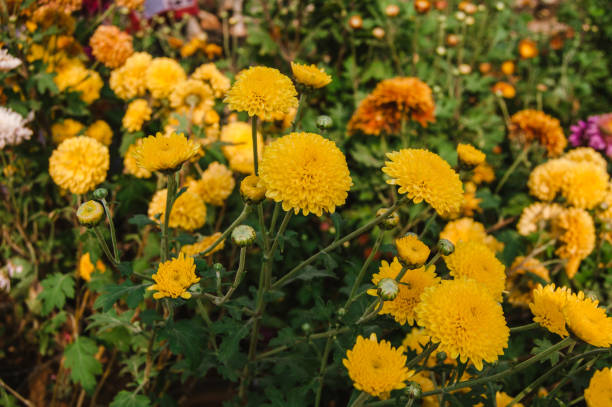Chrysanthemum morifolium is a flowering plant that has won the respect of horticulturists, herbalists, and flower enthusiasts all over the world. It is also referred to as the Florist’s Chrysanthemum or just the mum. This extraordinary species, which belongs to the Asteraceae family, is prized for its profound cultural roots, broad range of therapeutic uses, and breathtaking beauty and color diversity. This article explores the botanical features, cultural significance, medical use, and cultivation suggestions of Chrysanthemum morifolium, delving into a fascinating world of plants.
Table of Contents
Botanical Features: A Synopsis of Chrysanthemum Morifolium
The herbaceous perennial Chrysanthemum morifolium is native to Asia, mainly China and Japan. Its vivid blooms, which are available in a range of forms and hues such as white, yellow, red, purple, and multicolored patterns, and its luxuriant, deeply lobed leaves are what define it. The blooms are a versatile option for gardeners and florists, ranging from basic daisy-like forms to intricate spider varieties and elaborate pompons. Depending on the cultivar, the plant can reach heights of 30 to 90 centimeters. It prefers well-drained soil that receives lots of sunlight. Its late summer to late fall flowering cycle brings a burst of color to gardens and floral arrangements in the colder months.
Cultural Significance: Art, Tradition, and Symbolism of the Chrysanthemum
Many cultures have a high regard for Chrysanthemum morifolium, especially in East Asia. One of the “Four Gentlemen” of Chinese painting, the chrysanthemum represents dignity, grace, and the passage of the seasons. It is frequently connected to fall and the Confucian principles of honesty and tenacity. The flower is also used extensively in traditional Chinese medicine and cooking. The chrysanthemum, or “kiku,” is both the national flower and the Imperial Family’s emblem in Japan. The yearly Festival of Happiness, or “Kiku Matsuri,” honors the flower’s beauty and cultural significance and symbolizes longevity and rejuvenation. Chrysanthemums are also commonly used in Japanese poetry, art, and design, where they represent the aesthetic values of organic beauty and simplicity.
The therapeutic benefits of Chrysanthemum morifolium
Chrysanthemum morifolium has been utilized for generations in traditional medicine, in addition to its aesthetic value. Particularly the blossoms are valued for their medicinal qualities. Chrysanthemum tea is widely used in traditional Chinese medicine as a treatment for a variety of illnesses. It is said to be useful in treating colds, headaches, and respiratory problems due to its anti-inflammatory, anti-oxidative, and antibacterial qualities. In addition, the tea has a reputation for being relaxing, which lowers tension and enhances sleep. Chrysanthemum extracts are also utilized in skincare products because of their calming and anti-aging properties. Many of these traditional uses are supported by modern research, which also highlights the plant’s potential to enhance general health and well-being.
Cultivation Advice: Taking Care of and Growing Chrysanthemum Morifolium
For both new and seasoned gardeners, growing Chrysanthemum morifolium may be a gratifying experience. As long as they receive proper care and attention, these plants are rather easy to cultivate. The following are crucial pointers for cultivating chrysanthemums successfully:
Soil and Planting: Fertile, well-drained soil with a pH of 6.5 to 7.0 is ideal for Chrysanthemum plants. Since they need six hours a day of direct sunlight, plant them in a sunny spot. Make sure to space your plants appropriately to promote airflow and lower your chance of developing fungal illnesses.
Fertilization and Watering: Maintain a constant, slightly damp but not soggy soil. In order to prevent disease-causing wetness of the foliage, water the plants from the base up. Healthy development and an abundance of blooms are encouraged by regular feeding with a balanced fertilizer. Fertilize in the early spring and keep going until the buds appear.
Pruning and pinching: Throughout the growing season, pinch back the tips of the plants many times to promote bushier growth and more blossoms. Deadheading spent blossoms extends the blossoming season and maintains the plants’ neat appearance.
Management of Pests and Diseases: Aphids, spider mites, and caterpillars are a few of the pests that can affect chrysanthemum plants. Examine the plants frequently, and if necessary, apply neem oil or the proper insecticidal soap. Avoid overhead watering and make sure there is adequate air circulation to prevent fungal illnesses.
Overwintering: To shield the roots from freezing temperatures in areas with lower temperatures, apply mulch around the base of the plants. Chrysanthemums can also be dug out and brought indoors for the winter as annual plants.
Conclusion: Chrysanthemum Morifolium’s Everlasting Appeal
Beyond only being a stunning flower, Chrysanthemum morifolium is a source of natural medicine, a symbol of cultural legacy, and an example of the wonders of nature. It is a popular plant in gardens and homes all around the world because of its vivid blooms and fascinating history. Everyone can find something to like about the chrysanthemum, whether it’s its visual appeal, its medical qualities, or its cultural significance. Chrysanthemum morifolium has a timeless charm that gardeners and enthusiasts can continue to enjoy for decades to come by learning about its demands and appreciating its special traits.




